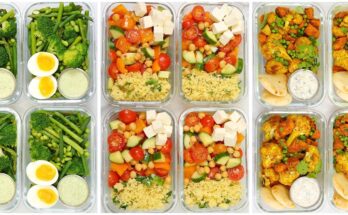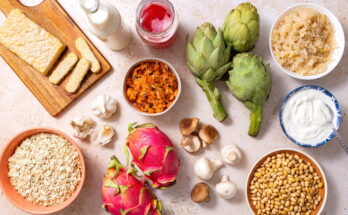Matzo Ball Recipe: Matzo balls, also called kneidlach (the Yiddish plural of kneidel), are soft, pillowy dumplings made from matzo meal, eggs, water, and fat. These delicious little orbs are a Jewish comfort food staple, most commonly served in a savory chicken broth. Whether you’re making them for Passover or just craving something warm and homey, matzo balls are the heart and soul of Jewish-style chicken soup.
At their core, matzo balls are all about balance—the right mix of ingredients, time, and love. Some people like them light and fluffy, others prefer them a bit more dense and chewy. No matter your style, the satisfaction of that first spoonful is universally comforting.
A Brief History of Matzo Balls
The origins of matzo balls trace back to Ashkenazi Jewish communities in Eastern Europe. Originally, Jews made dumplings from leftover scraps of matzo during Passover, when leavened bread is forbidden. Over time, these dumplings evolved into the matzo balls we know today.
In the early 20th century, with the rise of commercial matzo meal and the proliferation of Jewish delis and kitchens in places like New York, matzo balls became a beloved symbol of Jewish-American cuisine. Now, you’ll find them in homes and restaurants year-round, often regarded as a warm hug in a bowl.
Ingredients You’ll Need
Core Ingredients for Matzo Balls
To make classic matzo balls, you need a few essential pantry staples. Here’s your base:
- Matzo meal: This is finely ground matzo, and it’s the structural base.
- Eggs: Acts as a binder and helps the dough puff up.
- Water or broth: Adds moisture.
- Fat: Traditional recipes call for schmaltz (chicken fat), but you can use oil or butter (non-Passover).
- Salt and pepper: For flavor.
These simple ingredients are magical together when combined the right way. The chemistry between the eggs and matzo meal determines the final texture.
Additional Ingredients for Flavor Boost
While purists stick to the basics, a few additions can enhance the flavor:
- Fresh herbs: Parsley, dill, or chives bring freshness.
- Garlic powder or onion powder: A savory lift.
- Seltzer water: Adds fluffiness.
- Baking powder: Controversial during Passover, but it helps create fluffier balls (only if your traditions allow).
You can also spice things up with a dash of paprika or a spoonful of finely grated onion. Customizing your matzo balls to your palate is part of the joy of making them.
Choosing Between Fluffy and Firm Matzo Balls
Texture Tips Based on Preference
The eternal matzo ball debate: fluffy versus dense. It all comes down to personal preference. Some folks want matzo balls that float like clouds; others want them with a bit of chew, something you can sink your teeth into.
If you want fluffier matzo balls, aim for a wetter mixture with a bit of seltzer water or baking powder. Chilling the dough also helps with lightness because it allows the matzo meal to absorb moisture, making the balls less likely to fall apart when boiled.
Prefer a denser texture? Use a little less liquid and skip the seltzer. Handle the mixture gently, and don’t overwork it when forming the balls.
How Egg and Fat Content Affects Texture
Eggs and fat are the yin and yang of matzo ball texture. More eggs mean lighter, airier balls. More fat makes them richer and softer. Schmaltz gives matzo balls a uniquely rich flavor that’s hard to beat, but vegetable oil works well too.
If you’re going for luxurious texture and flavor, don’t skimp on the fat. A good rule of thumb? Use one tablespoon of fat per egg. Keep that balance, and you’ll be well on your way to matzo ball mastery.
Step-by-Step Guide to Making Matzo Balls
Step 1: Gather Your Ingredients
Here’s your shopping list:
- 1 cup matzo meal
- 4 large eggs
- 4 tablespoons schmaltz (or vegetable oil)
- 1/4 cup water or broth
- 1 teaspoon salt
- 1/2 teaspoon black pepper
- Optional: 1/2 teaspoon baking powder, 1 tablespoon chopped fresh herbs
Lay everything out before you start. Cooking is so much smoother when you’re not running back and forth to the fridge mid-recipe.
Step 2: Mix the Matzo Meal Mixture
Crack the eggs into a large bowl. Beat them well, then stir in your fat, water or broth, salt, pepper, and any herbs or spices you’re using. Once it’s well combined, gently fold in the matzo meal. Don’t overmix—it can make the balls tough.
The mixture should be soft but not too sticky. It will firm up during chilling.
Step 3: Chill the Dough
This step is non-negotiable. Cover the bowl and let the mixture chill in the refrigerator for at least 30 minutes. This resting period gives the matzo meal time to hydrate fully, which helps the balls hold their shape during cooking.
Chilling also makes it easier to roll the dough into neat, round balls without sticking to your hands. Think of it as the “calm before the boil.”
Step 4: Form the Balls
After the dough has chilled, it’s time to roll it into balls. Wet your hands lightly with cold water or oil to prevent sticking. Scoop out a heaping tablespoon of the mixture and gently roll it into a smooth ball between your palms. Don’t pack the mixture too tightly—loose rolling helps create a lighter texture.
You should get around 10 to 12 matzo balls from this recipe, depending on the size you make. Place them on a parchment-lined tray or plate as you go, spacing them slightly apart.
Step 5: Boil to Perfection
Fill a large pot with salted water or chicken broth and bring it to a gentle boil. Carefully drop the matzo balls into the liquid, one at a time. Reduce the heat to a simmer and cover the pot with a lid.
Let the matzo balls cook for about 30 to 40 minutes. Don’t open the lid too often—this traps the steam and helps the balls cook evenly. They should expand in size and become tender throughout.
Test one by slicing it in half. It should be cooked through without any raw doughy center. When they’re ready, gently scoop them out with a slotted spoon and transfer them to your soup or serving dish.
Common Mistakes to Avoid
Overmixing the Dough
It’s tempting to stir the mixture until it’s super smooth, but resist that urge. Overmixing can lead to tough, rubbery matzo balls. Mix just until the ingredients are combined, then let the dough rest in the fridge. Trust the process—resting will do the heavy lifting for you.
Overmixing also activates the gluten in the matzo meal, even though it’s minimal. This makes the dough less tender and can ruin that ideal fluffy texture.
Using Boiling Water vs. Simmering
A rolling boil may seem like a good idea, but it can break apart delicate matzo balls or make them cook unevenly. Instead, aim for a gentle simmer. Small bubbles should rise to the surface without vigorous movement.
Simmering allows the balls to cook through slowly, expand properly, and hold their shape. If your pot starts to boil aggressively, turn the heat down and cover it loosely to maintain a gentle temperature.
Tips for Perfect Matzo Balls Every Time
Best Broth for Cooking
While plain salted water works fine, using chicken broth adds depth and richness. Homemade broth, with carrots, celery, onion, and herbs, is the gold standard. It infuses the matzo balls with flavor as they cook and complements their texture perfectly.
If you’re short on time, boxed broth or bouillon works too. Just make sure to taste and adjust the seasoning—matzo balls absorb flavor like sponges, and a bland broth can dull the final dish.
Storage and Reheating Tips
Matzo balls keep well in the fridge for up to 4 days. Store them in a sealed container, ideally in some broth to keep them moist. If you’re making them ahead of time, let them cool completely before refrigerating.
To reheat, place them gently in simmering broth for 10 to 15 minutes, or microwave them in a covered dish with a bit of broth. They can also be frozen: lay them on a baking sheet to freeze individually, then store them in freezer bags. Reheat directly from frozen in hot broth for best results.
Serving Suggestions
Traditional Pairings
The classic serving style is simple and satisfying: matzo balls floating in a bowl of golden chicken soup. Add some cooked carrots, celery, and shredded chicken for a complete meal. A sprinkle of fresh dill on top is the finishing touch.
This is Jewish comfort food at its finest, especially during holidays or when someone’s feeling under the weather.
Creative Serving Ideas
Want to try something new? Here are a few creative ways to serve matzo balls:
- Matzo Ball Sliders: Slice them in half and use them like buns with brisket or pulled chicken.
- Stuffed Matzo Balls: Before rolling, insert a small piece of cooked mushroom or seasoned beef inside.
- Herbed Matzo Balls: Infuse with basil, thyme, or tarragon for a twist.
- Vegetarian Delight: Serve them in vegetable broth with peas, spinach, or roasted tomatoes.
These variations breathe new life into the traditional dish and are perfect for experimenting in the kitchen.
Nutritional Information
Caloric Content
Matzo balls are generally moderate in calories. One medium matzo ball (cooked in broth) typically contains about:
- Calories: 80–100
- Fat: 4–6 grams (depending on oil used)
- Protein: 2–3 grams
- Carbohydrates: 8–10 grams
If you’re watching your intake, consider using less oil or making smaller balls.
Dietary Considerations
Matzo balls are naturally dairy-free and can be made gluten-free using certified gluten-free matzo meal. They’re also highly adaptable—use egg substitutes for a vegan version, or switch up the fat to suit dietary needs.
Remember to check the broth’s ingredients too, especially for sodium and added preservatives if using store-bought options.
FAQs about Matzo Ball Recipe
Q1: What are matzo balls made of?
Matzo balls are traditionally made from matzo meal, eggs, water, and oil or chicken fat (schmaltz). Some recipes also include baking powder or seltzer for fluffier balls.
Q2: Can I make matzo balls ahead of time?
Yes, you can make them a day in advance. Store cooked matzo balls in a sealed container with a bit of broth to keep them moist. Reheat in soup before serving.
Q3: Why are my matzo balls too hard?
Hard matzo balls are often caused by overmixing or not letting the mixture rest before forming. Let the dough chill for at least 30 minutes before shaping to help them stay tender.
Q4: How do I make fluffy matzo balls?
Use seltzer water instead of plain water and avoid over-packing the mixture when forming the balls. Cooking them in a covered pot also helps create a lighter texture.
Q5: Are matzo balls gluten-free?
Traditional matzo balls are not gluten-free because matzo meal contains wheat. However, you can use certified gluten-free matzo meal as a substitute.
Q6: Can I freeze matzo balls?
Yes, cooked matzo balls freeze well. Let them cool completely, place them on a baking sheet to freeze individually, then store them in a ziplock bag. Reheat directly in simmering broth.
Q7: Should matzo balls be cooked in water or broth?
For best flavor, cook matzo balls directly in chicken broth. However, you can cook them in salted water if you prefer to keep the broth clear.
Q8: How long should I cook matzo balls?
Matzo balls usually take about 30–40 minutes to cook through. They should be light, tender, and puffed up when ready.
Q9: What’s the difference between sinkers and floaters?
“Sinkers” are dense matzo balls that stay at the bottom of the pot. “Floaters” are light and airy, floating on top of the broth—usually the result of using seltzer or baking powder.
Q10: Can I add herbs or spices to matzo balls?
Absolutely! Dill, parsley, garlic powder, or onion powder can be mixed into the batter for added flavor.
Conclusion
Matzo balls are more than just dumplings—they’re a symbol of tradition, love, and comfort. Whether you’re serving them for Passover, a holiday dinner, or just to lift someone’s spirits, mastering the art of the matzo ball is a worthy culinary journey.
From selecting the right ingredients to perfecting the simmer, each step in this guide brings you closer to a bowl of soul-warming goodness. Now that you’ve got the know-how, it’s time to roll up your sleeves and make a batch of your own.



